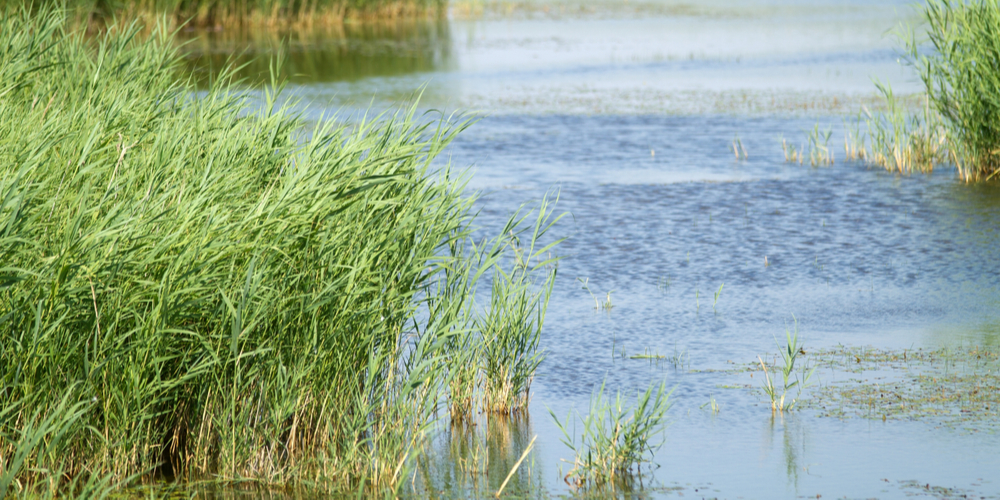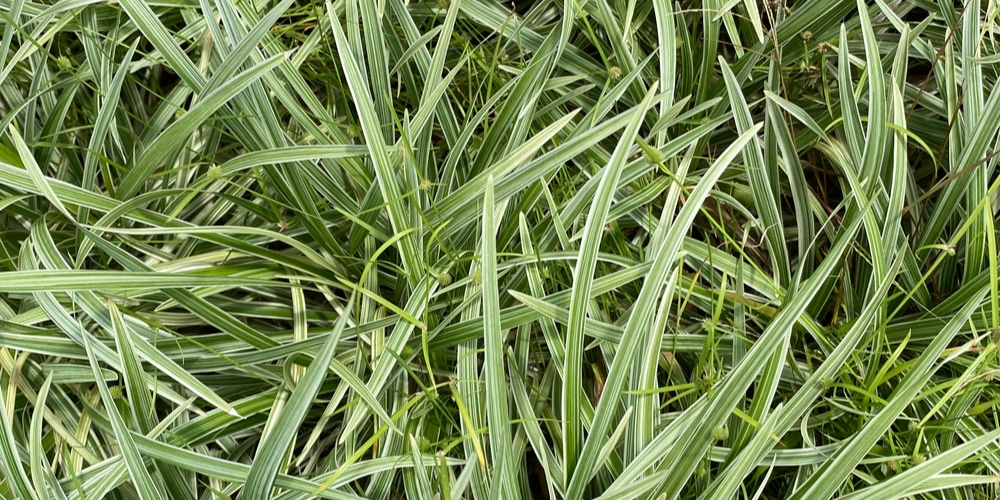Peppermint Stick Grass, also known as Arundo Donax, is a type of grass that is native to the Mediterranean region. The plant gets its name from its long, slender leaves, which are similar in shape to peppermint sticks.
Peppermint Stick Grass grows to be 6-12 feet tall and has numerous hollow stems that are hairless and round in cross-section.
While Peppermint Stick Grass is not typically used as ornamental grass, it has many benefits that make it ideal for landscaping purposes. For example, the plant is very drought-tolerant and can thrive in both hot and cold climates. It’s deer-resistant and can help prevent soil erosion.
| Botanical Name | Arundo Donax |
| Common Name | Peppermint Stick, Giant Reed |
| Plant Type | Perennial |
| Flower Color | Bronze |
| Size When Mature | 144 inches |
| Bloom Time | Late summer to mid-fall |
| Sun Requirements | Full sun, tolerates shade |
| USDA Hardiness Zones | 6a – 10b |
| Soil PH Range | 5.5 – 6.0 |
| Soil Type | Rich, well-draining, acidic |
| Water Needs | Medium |
| Native Area | Mediterranean region |
What You Need to Know About Peppermint Stick Grass
This striking grass has variegated white and green foliage, with wide, corn-like leaves that create a dense canopy. It boasts broad leaves that taper to a point, much like blades of grass. It produces tall clusters of delicate white flowers that bees and butterflies adore in late summer and fall.
The plant is fast-growing and can quickly reach its maximum height of 6 to 12 feet. Once it matures, it produces long, thin seed heads that resemble peppermint sticks.
Aside from its height and its visual appeal, this grass is also known for its hardiness, adaptability, and ease of care. Once established, it is resistant to drought and can tolerate even poor soil conditions, requiring less fertilizer and water than other types of grass.
While it is not typically used as ornamental grass, peppermint stick grass can add a unique and stylish touch to any garden or landscape. If you’re looking for low-maintenance grass and easy to care for, peppermint stick grass is a great option.
How to Care for Peppermint Stick Grass
Here’s everything you need to know about growing and caring for a thriving peppermint stick grass:
Light
One of the beautiful things about Peppermint Stick Grass is that it’s pretty easy to care for. Prized for its versatility, this sun-loving grass can grow in both full sun and partial shade.
However, it’s important to note that the plant will produce more flowers and seed heads if it’s grown in full sun. It won’t grow vigorously in shady areas, so if you’re looking for a groundcover, sun exposure is a must.
A bit of afternoon shade is ideal if you live in a hot climate. The scorching sun can cause the leaves to turn brown and wilt.
While not commonly grown in pots, some gardeners have had success growing peppermint stick grass in containers as long as they’re placed in a sunny spot. Place it in an area near the window, which receives at least 6 hours of sunlight per day.
This fast-growing grass can quickly reach its maximum height of 6 to 12 feet, so make sure to plant it in an area where it has plenty of room to spread out.
Water and Soil Needs
This type of grass thrives in most types of soil as long as the pH is acidic to neutral. It’s also relatively drought-tolerant, so it doesn’t need a lot of water to stay healthy. However, if you live in an area with hot, dry summers, you may want to give your peppermint stick grass extra watering during the driest months to prevent the leaves from browning.
Whether you’re planting in your garden or in a pot, make sure there is a layer of gravel or sand at the bottom to improve drainage. The plant’s roots can rot if they sit in waterlogged soil for too long.
Temperature Requirements
Though it’s often associated with tropical sandy beaches, peppermint stick grass (Arundo donax) is actually a hardy plant that can survive in a wide range of climates. In fact, this towering grass is capable of thriving in USDA climate zones 6a through 10b, meaning it can withstand both frigid winters and sweltering summers.
Whether you live in the sunny South or the snow-covered North, peppermint stick grass is a versatile plant that can add a touch of elegance to your landscape.
Fertilizer
The best fertilizer to use on peppermint stick grass is a nitrogen-rich fertilizer that’s applied in the spring. This will help the plant to grow new leaves and produce more flowers. You can also use a compost tea or other organic matter to fertilize your peppermint stick grass yearly.
Be sure to water the fertilizer into the soil to prevent root burn. This type of grass doesn’t need a lot of fertilizer, so don’t overdo it. Too much nitrogen can actually cause the plant to produce fewer flowers.
Common Diseases
Rust is a fungal disease that causes small orange or red lesions to form on the leaves of peppermint stick grass. If left untreated, rust can spread quickly and cause the leaves to turn yellow and eventually drop off.
Powdery mildew is another fungal disease that attacks both the leaves and stems of peppermint stick grass. This disease is characterized by a white or gray powdery substance that forms on the plant’s surface. Stem rot is a serious bacterial disease that can cause the stems of peppermint stick grass to break easily.
Peppermint stick grass is a fairly disease-resistant plant, but it can be susceptible to root rot and leaf spot if it’s grown in poorly drained soil.
These diseases are often caused by fungi or bacteria that thrive in wet conditions. To prevent these diseases from taking hold, make sure your peppermint stick grass is planted in well-drained soil.
This type of grass is also relatively pest-resistant, but it can be susceptible to aphids, mealybugs, and scale insects if it’s not properly cared for. These pests are often attracted to stressed or damaged plants.
To prevent these pests from taking up residence in your peppermint stick grass, make sure to water and fertilize it regularly. If you do notice pests on your plant, you can remove them by hand or treat the plant with insecticidal soap.
Peppermint Stick Grass Propagation
Peppermint Stick Grass is propagated by seed, division, or root cuttings. The easiest way to propagate the plant is by seed. The seeds should be sown in well-drained soil and kept moist until they germinate.
Once the seedlings have emerged, they can be transplanted into individual pots or into the garden.
Division is another easy method of propagation. The clumps of Peppermint Stick Grass can be divided in the spring or fall. Each clump should be divided into several smaller clumps, making sure that each one has a few roots attached.
The final propagation method is root cuttings. Root cuttings can be taken in the fall or winter when the plant is dormant. A sharp knife should be used to take 4-inch sections of roots. These sections should be planted in well-drained soil and kept moist until they sprout new growth.
Peppermint Stick Grass: Final Thoughts
With its tall, elegant plumes, peppermint stick grass is a beautiful addition to any landscape. It’s easy to care for this plant thanks to its versatility and disease resistance.
Whether you propagate it by seed, division, or root cuttings, peppermint stick grass is a plant that’s easy to grow and maintain.
So if you’re looking for a plant that will add a touch of beauty to your yard, peppermint stick grass is an excellent choice.


